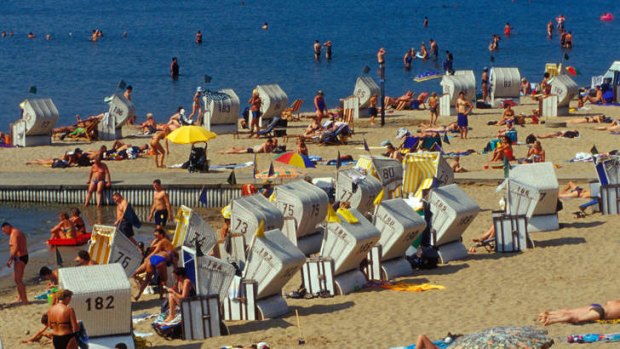
The shores of lake Wannsee, Berlin.Credit: Alamy
As Berlin prepares to mark the 25th anniversary of the fall of the great divider, Michelle Griffin takes a lakeside walk through layers of history.
Up close, what remains of the Berlin Wall looks fragile for something that once divided the superpowers: 3.6 metres of concrete high and less than 50 centimetres thick. The kilometre long stretch that still borders the Spree River has been thickly painted with murals of rainbows and doves. It is now a civic art project.
To get a better grasp of the power of a wall that divided communism and capitalism for 28 years, I take the train west, not east, to the forested suburbs of Wannsee and Babelsberg.
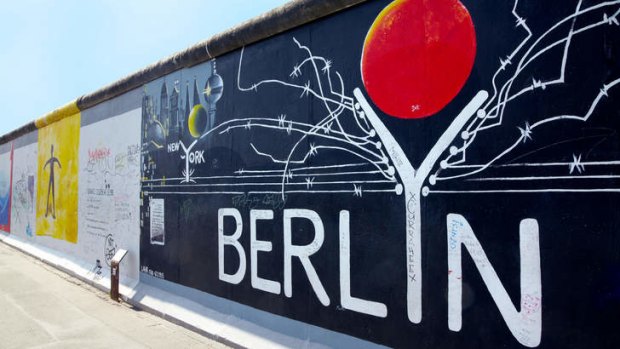
The East Side Gallery wall remnant.Credit: Alamy
Growing up, I’d always imagined the Wall running straight down the middle of the city, something out of Pink Floyd. It’s only once I’d arrived that I understood the wall as a loop, 155 kilometres of concrete, barbed wire and watch towers that cut off West Berlin from the surrounding country, save for the patrolled roads and train lines back to the west.
To walk the entire Mauerweg, or wall path, would take seven solid days. I’ve signed up for a historical walk of 14 kilometres across its outer western edge, on a small group tour led by Paul Scraton, an English man who has made extensive study of the wall’s traces.
“The borders of East and West Berlin were decided by postcodes,” he explains when he meets the five of us at Griebnitz see train station, once a border crossing for train passengers heading for the rest of the West. That, he said, is why the wall zig zagged through the city, jumping across the River Spree and back to seal off one city block from its neighbour.
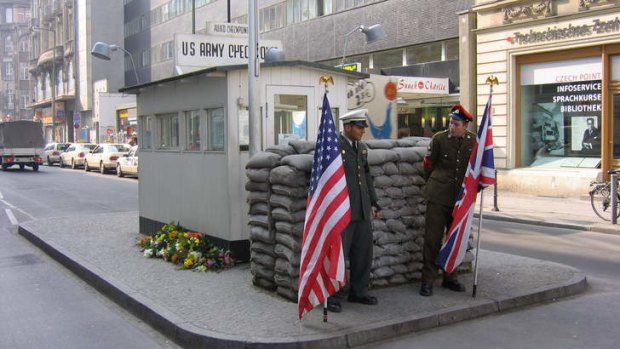
Checkpoint Charlie.
Scraton has a scholarly enthusiasm for the city’s less obvious historical stories. Married to a woman raised in East Germany (“an Ossie”), he’s walked and blogged many of the wall’s traces. The route he’s chosen for the tour ignores the well-known inner-city route north from Checkpoint Charlie, now a Disney cartoon of its former self, for a half day exploring not only the scars left by the wall, but other layers of history, from19th-century royal pleasure palaces to Nazi sites and today’s planning disputes.
We meet on what everyone tells us will be the last sunny day of the year. The shores of Lake Wannsee are ringed with crowds, faces raised to the sun. “Winter is coming,” everyone keeps saying, like Starks in Game of Thrones.
Bleak rains will arrive on schedule the next day, but the walk that Sunday would have been glorious even if we remained ignorant of its history; a long ramble through grand boulevards and forested trails by the shores of a sprawling lake. Wannsee was the place to which West Berliners could escape and enjoy a little open space, Scraton says – if they could ignore the watch towers on the farther shore.
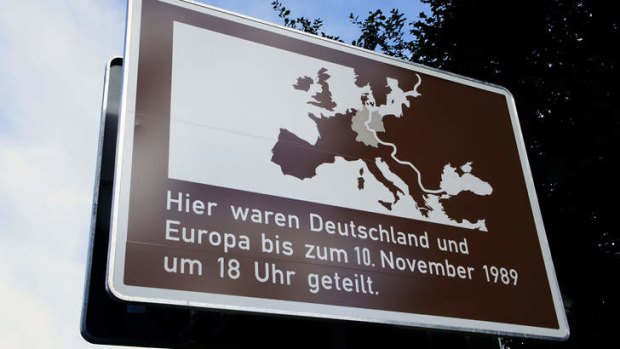
Signage at Glienicke bridge.Credit: Alamy
We walk west into what was East Berlin, or rather the edge of the East German city of Potsdam.
Where guards once patrolled the border with guns, we wander down avenues lined with Kaiser-era mansions. These days, they house TV producers and software entrepreneurs, and much of the old river route is locked away in private land. “Freies Ufer” signs – “free the shore” – are scattered along the streets, but access to the wall’s shoreline border costs millions of Euros now.
On prime waterside streets, Scraton points out three grand homes that hosted Churchill, Truman and Stalin when they came in 1945 to carve out a new world order at the Potsdam conference. Of the three, the grandest is Villa Urbig, Churchill’s digs, a many-gabled salmon pink chateau designed by Mies Van Der Rohe. It’s now owned by a property developer unenthusiastic about sharing his views with history buffs – although he did allow Churchill’s youngest daughter, Baroness Mary Soames, to walk the parquetry floors 10 years ago in the company of the German woman whose family was evicted from the mansion in 1945 by the Soviets to make way for such eminent guests.
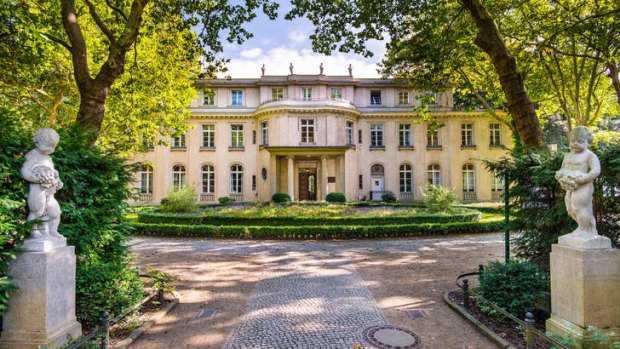
Wannsee House.Credit: Alamy
We follow the wall’s riverbank route past Wilhelm I’s neo-Gothic summer palace, tricked up with battlements and towers in 1833 to indulge the Prussian aristocracy’s enthusiasm for mediaeval England. Beyond, a narrow bridge takes us to a more recent fortress, designed not to withstand invasion but to lock in the inhabitants. The hamlet of Klein Glienicke was a tiny v-shaped foothold of East Germany on the West German side of the water, cut off from surrounding parklands by barbed wire fences, the one bridge out of town under constant surveillance.
A Berlin Wall Trail information board displays black-and-white photographs of a narrow tunnel dug under the border in 1973 by a couple who used their small children’s plastic shovels. It was an unusually dry year, our guide explains – normally the water table was too high to allow locals to dig their way out. West and by a scrap of fence where West Germans once gathered to watch the burial of an East German relative in the town’s cemetery.
We stop for thermos tea and packed lunch just beyond the village, on a curved stone bench next to the Glienicke Bridge, better known as The Bridge of Spies.
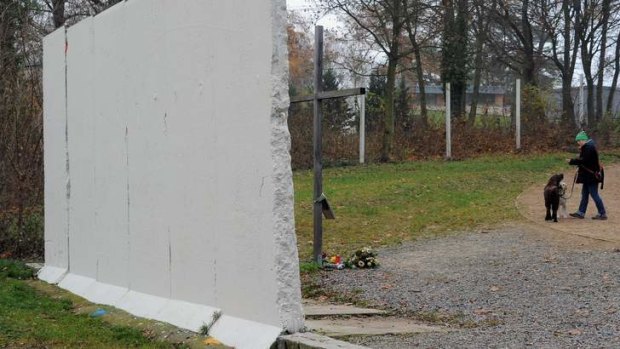
A section of The Wall preserved as a monument.Credit: Corbis
Spies and Cold War soldiers were exchanged four times under the bridge’s iron arches: in 1960, in 1964, in 1985 and for the last time in 1986when five KGB spies, including CIA double agent Karl Koecher, were exchanged for Russian/Israeli human rights campaigner Natan Shcharansky, who’d spent many years in a Siberian gulag.
Although the sense of mystery is now compromised by the tour buses roaring to Potsdam, we flip our collars and hunch shoulders to make like Karla, the Soviet superspy who defects at the climax of John Le Carre’s 1979 novel Smiley’s People. We can add the eerie mood later, in Instagram.
From here, the wall walk leaves the main road to take a dirt track along the edge of the River Havel, shaded by birches, pines and oaks. Cyclists zoom past on one side as boats putter by on our left, but our walking group ambles at an idle pace. This is the stretch, says Scraton, where he can stop talking at us for awhile and just let thoughts ramble. Conversation drifts to politics in our little group: an Indian software programmer, a Bulgarian business investor couple, an American theatre maker, my arts programmer husband and me, the journalist.
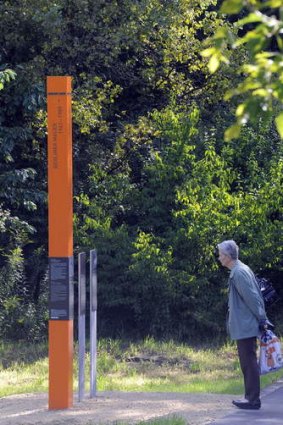
An information point along the wall trail.Credit: Corbis
We compare 2013 election campaigns in Australia and Germany, both plagued by debates about immigrants. German politics, for once, seems comfortably staid. We muse a little on Germany’s new role bailing out debt-ridden Eurozone nations, a role that carries an unsettling level of pan-European clout.
Across the water, we can see the Italianate tower and colonnades of the Heil and skirche in Sacrow, which was sealed off from its parish for almost three decades.
Now concerts are held in grounds that were once decrepit and overgrown. A little further along we can see the white wedding-cake facade of a palace built on Peacock Island at the end of the 18th century for the chief mistress of sybarite monarch Friedrich Wilhelm II, who was colloquially known as “der dicke Luderjahn”.
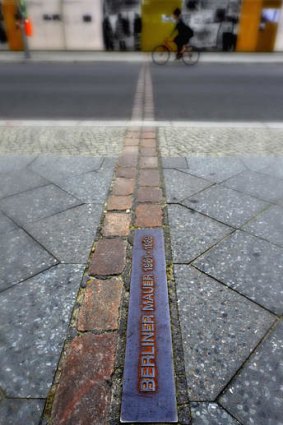
The wall's track across the street near Checkpoint Charlie.Credit: Getty Images
Though it translates as “fat good for- nothing”, historian Ulrich Feldhahn notes it as an affectionate nickname.
You can catch a ferry across to the island, but our tour takes us around the undulating shores of Lake Wannsee, a summery cerulean blue. Across the in let we can see a wide crescent of yellow sand crowded with sunbathing Germans determined to soak up that last dose of vitaminD.
Berliners have always loved this little beach, Scraton tells us. In the 1920s, communists and fascists battled for occupation of metres of sand in rehearsals of the more vicious battles ahead.
The forest path ends at a little marina, which services a small colony of lakeside villas, hostels and holiday homes. The first one we pass is the infamous Villa Minoux, a white mansion set back from the street behind a high concrete wall. On January 20, 1942, high-ranking Nazis gathered at a conference helmed by Director of the Reich Main Security Office Reinhard Heydrich to work out the details of "the final solution to the Jewish question" – the industrialised mass murder of Europe's Jewish population.
These days, the site of the Wannsee Conference is a Holocaust memorial, and information boards fill its formal green gardens and airy rooms with the full impact of that business meeting by a winter lake. Walking in Berlin will often cause you to stop short, says Scraton. You can be walking along in dappled sunshine when you encounter a site that demands you stop daydreaming and consider instead the brutal course of history.
We end our walk by paying our respects around the corner at the gates of the home of painter Max Liebermann. A president of the Prussian Arts Academy, the grand old man of German impressionism resigned his post when the Nazis came to power in 1933. The son of a Jewish banker, he famously declared during Hitler’s victory march through the Brandenburg Gate: “Ich kann gar nicht soviel fressen, wie ich kotzen mochte.’’ (‘‘I cannot eat as much, as I would like to puke’’. He died two years later, aged 88, as Berlin entered its darkest era.
The tour ends now, says Scraton, to provide some kind of antidote to the Wannsee Conference.
This is why four hours walking along the water on a sunny day proves so extraordinary. The traces of the wall don’t just mark the brutal division of east and west Germany. Walking the border trail with a knowledgeable guide, you can read through the 20th century into the present day. The paths of Berlin serve as a fault line for three moments in the past century when the fabric of world history was torn apart, first in World War I, then under the Nazis, and finally the centre of the Cold War.
The writer travelled at her own expense.
TRIP NOTES
GETTING THERE
Lufthansa has a fare to Berlin for about $2390 low-season return from Melbourne and Sydney including taxes. Fly to Singapore (about 8hr with Singapore Airlines), then to Frankfurt (13hr 5min) and then to Berlin (1hr 10min); see lufthansa.com. To walk the Berlin Wall Trail along the lake, take the S1 train line (Potsdam direction) from Friedrichstrasse Station and get out at Griebnitzsee or Wannsee station. By car or taxi, take the A10 route (direction Dresden). See slowtravelberlin.com/tours/hiking-the-berlin-wall/.
TOURING THERE
A Hike Along the Berlin Wall: a 15km tour from Griebnitzsee to Wannsee. €15 ($23) a person for groups of up to six. The Slow Travel Berlin English language city guide website organises several other walking tours. See slowtravelberlin.com/tours/.
STAYING THERE
There are many holiday homes and pensions along the lake. At Pension Babelsberg, rooms range from €59 a night for a single room in low season to €250 a night for a six-person apartment in high season. See apartpension.de/en/hotel-with-flair.
MORE INFORMATION
CORRECTION: An earlier version of this story said the 1942 conference was chaired by SS chief Heinrich Himmler, not Director of the Reich Main Security Office Reinhard Heydrich. The mistake was made by the writer.
Sign up for the Traveller Deals newsletter
Get exclusive travel deals delivered straight to your inbox. Sign up now.